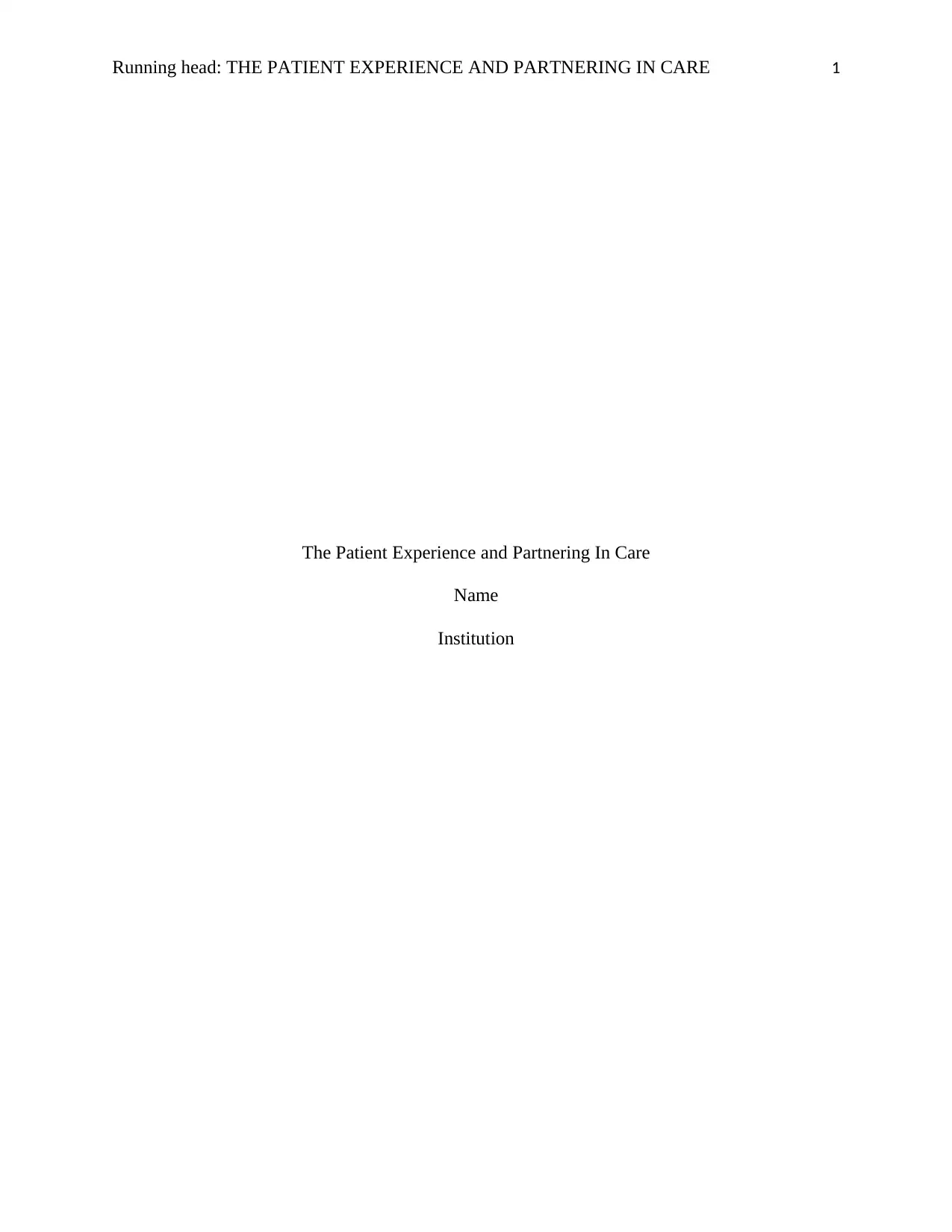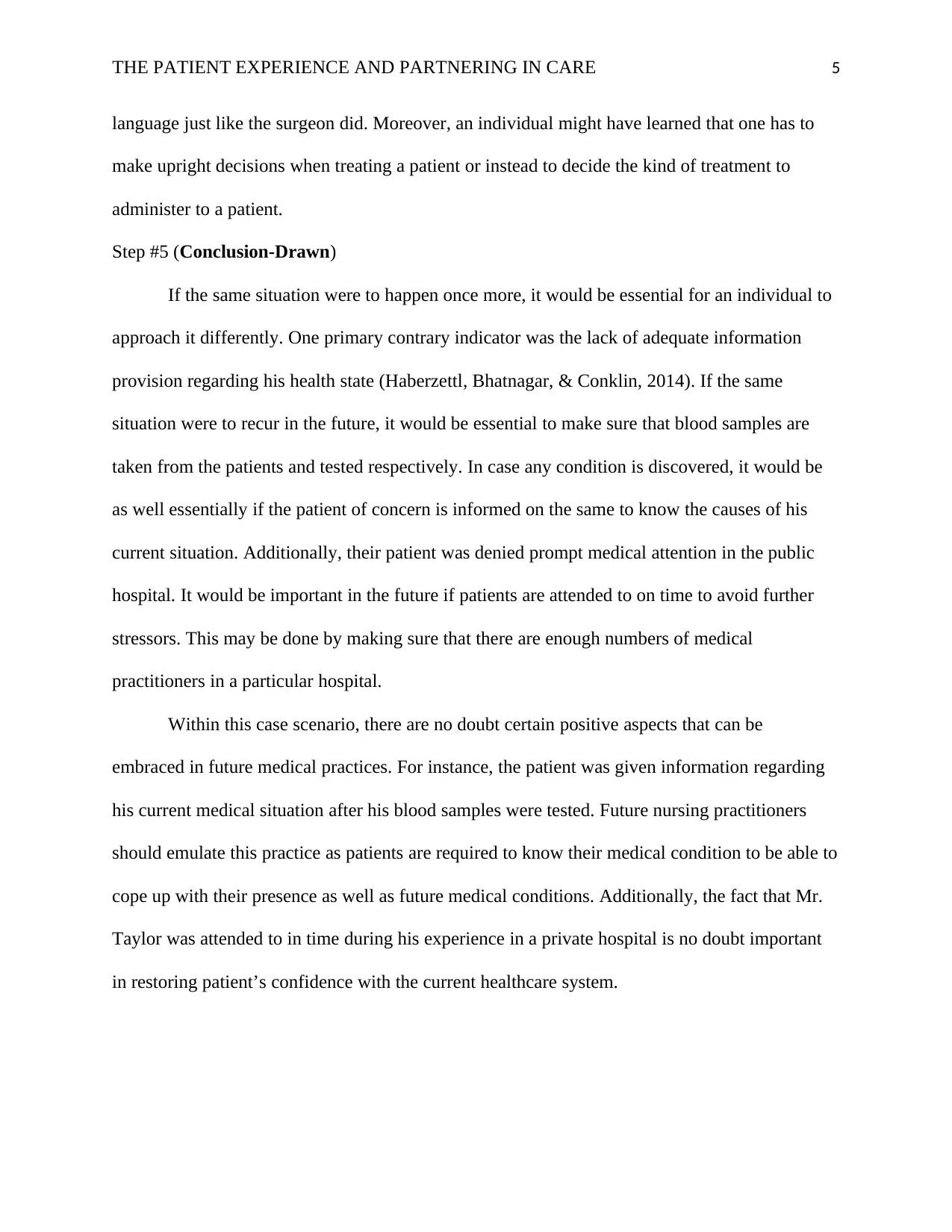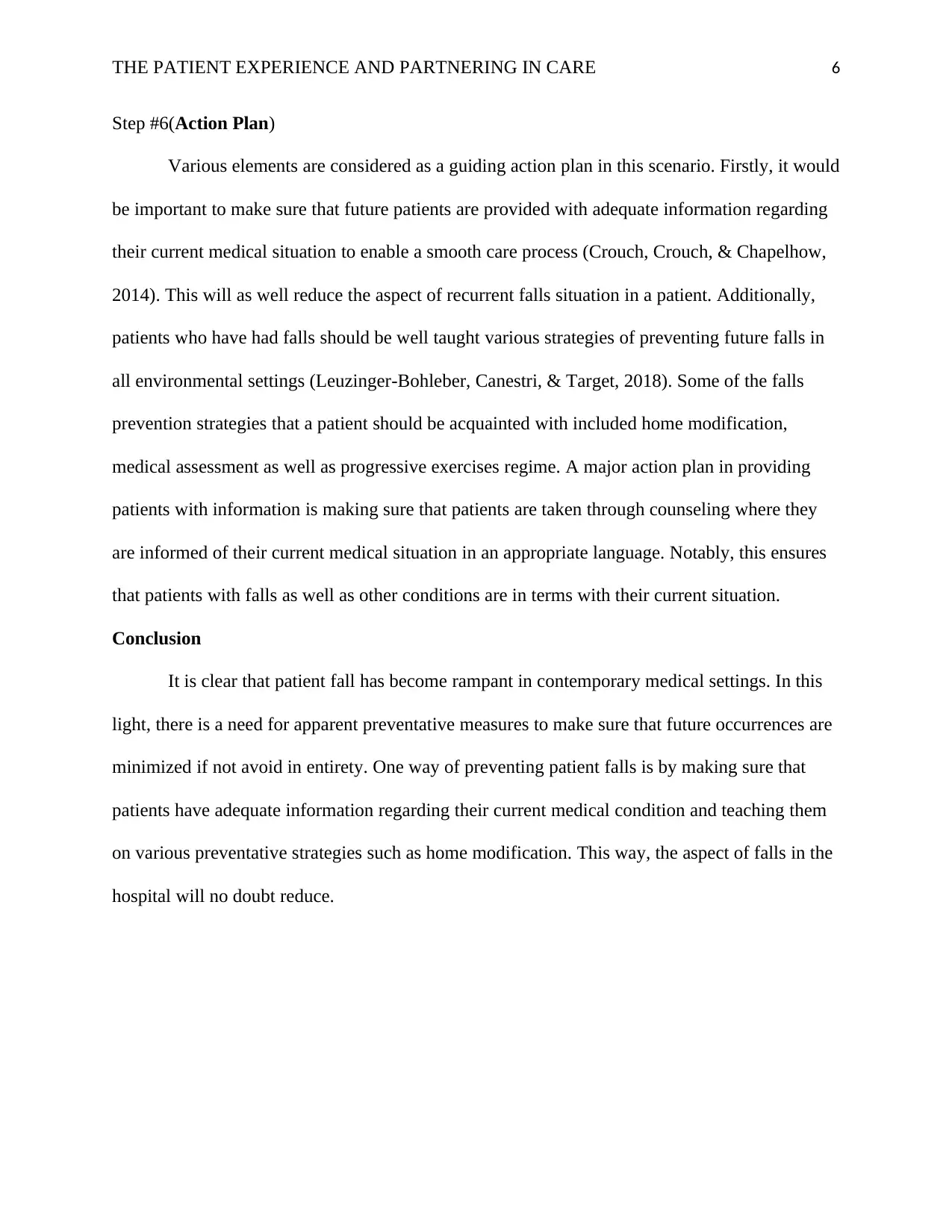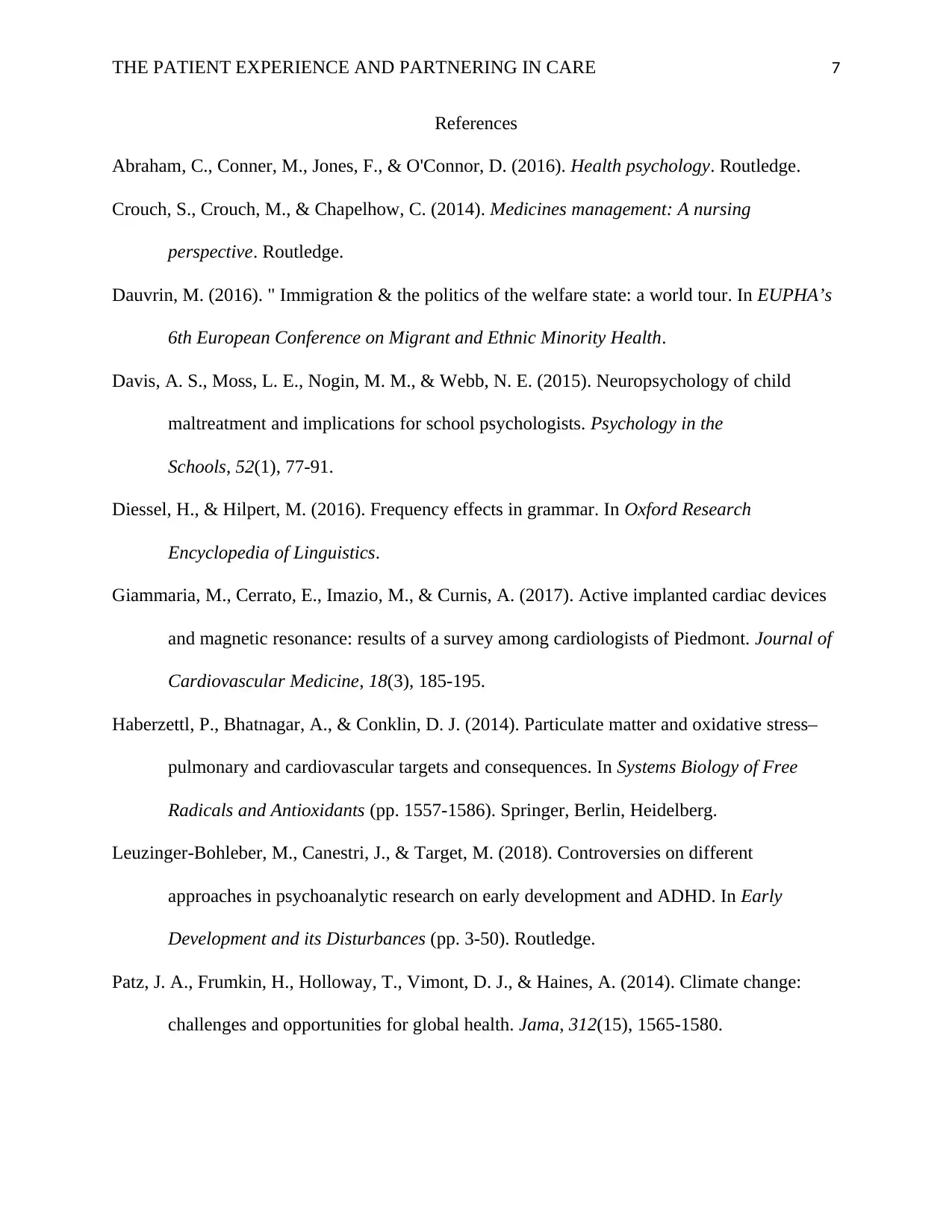NUR1201 S2 2018: Analyzing Patient Experience Using Gibb's Model
VerifiedAdded on 2023/06/03
|8
|2182
|357
Essay
AI Summary
This essay uses Gibb's Reflective Cycle to analyze a patient's experience with falls in healthcare settings. It covers the patient's positive and negative experiences in public and private hospitals, focusing on the lack of information provided regarding fall prevention. The reflection delves into feelings of sympathy and anger, evaluating the overall event and analyzing the importance of providing patients with adequate information and timely medical attention. The conclusion emphasizes the need for improved communication, preventative strategies, and prompt care to enhance patient confidence and minimize future occurrences of falls. The essay also includes an action plan for future scenarios, focusing on patient education and counseling. Desklib offers a range of study tools and resources for students.

Running head: THE PATIENT EXPERIENCE AND PARTNERING IN CARE 1
The Patient Experience and Partnering In Care
Name
Institution
The Patient Experience and Partnering In Care
Name
Institution
Paraphrase This Document
Need a fresh take? Get an instant paraphrase of this document with our AI Paraphraser

THE PATIENT EXPERIENCE AND PARTNERING IN CARE 2
The Patient Experience and Partnering In Care
Patient’s Experience Using Gibb’s Reflection Cycle
Ideally, patient falls has undoubtedly become one of the most frequent events in the
corridor of healthcare facilities thus affecting the overall safety of patients. Consequently,
various methods are required in preventing falls among patients. However, recognizing,
evaluating as well as preventing the aspect of patient falls has become a significant problem for
the healthcare practitioners in the haste of providing a safe environment in a particular healthcare
setting. In this light, various hospitals have come together with the aim of understanding the
contributing factor of patient falls as well as decreasing their occurrence and the resulting overall
injuries or slightly deaths. This paper proposes to discuss in detail the aspect of patient falls by
the use of Gibb’s reflection cycle on Mr. Taylor’s experience.
Step #1 (Description)
In essence, this is a step that closely looks at the aspect of quality in regards to the
patient’s experience thus providing nurses with tools of assessing the same. For instance, this
scenario is meant to acknowledge nurses with the need of preventing patient’s fall in a particular
healthcare system as well as keeping records on falls. This scenario is about a 75 years old
patient named Mr. Taylor who has undoubtedly undergone various events regarding medical as
well as surgical experience as a result of falls. Nonetheless, his entire experience has been
surrounded with both positive as well as negative aspects in public as well as the private hospital.
One apparent negative aspect of his experience is that the doctors in public hospital did not
consider taking his blood samples for testing or even informing him of fall prevention strategies.
However, one clear positive experience was that Mr. Taylor was informed about his current
situation. The main themes that are presented in this scenario are the aspect of the lack of
The Patient Experience and Partnering In Care
Patient’s Experience Using Gibb’s Reflection Cycle
Ideally, patient falls has undoubtedly become one of the most frequent events in the
corridor of healthcare facilities thus affecting the overall safety of patients. Consequently,
various methods are required in preventing falls among patients. However, recognizing,
evaluating as well as preventing the aspect of patient falls has become a significant problem for
the healthcare practitioners in the haste of providing a safe environment in a particular healthcare
setting. In this light, various hospitals have come together with the aim of understanding the
contributing factor of patient falls as well as decreasing their occurrence and the resulting overall
injuries or slightly deaths. This paper proposes to discuss in detail the aspect of patient falls by
the use of Gibb’s reflection cycle on Mr. Taylor’s experience.
Step #1 (Description)
In essence, this is a step that closely looks at the aspect of quality in regards to the
patient’s experience thus providing nurses with tools of assessing the same. For instance, this
scenario is meant to acknowledge nurses with the need of preventing patient’s fall in a particular
healthcare system as well as keeping records on falls. This scenario is about a 75 years old
patient named Mr. Taylor who has undoubtedly undergone various events regarding medical as
well as surgical experience as a result of falls. Nonetheless, his entire experience has been
surrounded with both positive as well as negative aspects in public as well as the private hospital.
One apparent negative aspect of his experience is that the doctors in public hospital did not
consider taking his blood samples for testing or even informing him of fall prevention strategies.
However, one clear positive experience was that Mr. Taylor was informed about his current
situation. The main themes that are presented in this scenario are the aspect of the lack of

THE PATIENT EXPERIENCE AND PARTNERING IN CARE 3
information to patients regarding patient’s prevention techniques even though there are adequate
cares for particular presenting conditions.
Step #2 (Feeling)
During the consultation, I undoubtedly had different feelings. I felt sympathetic for
Taylor because his experience reminded me of the time I was a teenager. I had an accident when
I was 14 years, and I could not withstand the pain I had gone through not forgetting the fact that I
had diabetes and asthma. In a review from Dunn, O’Neill, as well as Feldman (2014) I found out
those patients who suffer from injuries as a result of accidents, is at risk of experiencing
depression from such a horrible experience (Diessel & Hilpert, 2016). However, the review also
concluded that treatment and close care could improve the psychological trauma (Dauvrin,
2016). My experience of that accident meant that I could relate well to that patient. I felt some
anger at one point during the consultation. The excitement was directed to the practitioners who
made Taylor wait for 11 hours before he could get medical attention (Giammaria, Cerrato,
Imazio, & Curnis, 2017). Additionally, I was angry because of how public hospitals treated its
patients with no instance care. I was pitiful for Taylor’s father for being wrongly amputated.
Step #3 (Evaluation)
On evaluation, the overall event was somehow good in a way. First, it added to an
individual’s dealing with old adult and dealing with patients who have had accidents. Although
someone might not have had much experience with an old adult, he or she would surely welcome
such a challenge in the course of their career. Additionally, this experience no doubt reaffirmed a
person’s choice as a nurse (Philpott, Nandurkar, Lubel, & Gibson, 2014). During a person’s
career journey, one may have a little doubt on whether or not he or she has chosen the right path.
Nonetheless, there is always some point where one feels that he or she has made the right choice.
information to patients regarding patient’s prevention techniques even though there are adequate
cares for particular presenting conditions.
Step #2 (Feeling)
During the consultation, I undoubtedly had different feelings. I felt sympathetic for
Taylor because his experience reminded me of the time I was a teenager. I had an accident when
I was 14 years, and I could not withstand the pain I had gone through not forgetting the fact that I
had diabetes and asthma. In a review from Dunn, O’Neill, as well as Feldman (2014) I found out
those patients who suffer from injuries as a result of accidents, is at risk of experiencing
depression from such a horrible experience (Diessel & Hilpert, 2016). However, the review also
concluded that treatment and close care could improve the psychological trauma (Dauvrin,
2016). My experience of that accident meant that I could relate well to that patient. I felt some
anger at one point during the consultation. The excitement was directed to the practitioners who
made Taylor wait for 11 hours before he could get medical attention (Giammaria, Cerrato,
Imazio, & Curnis, 2017). Additionally, I was angry because of how public hospitals treated its
patients with no instance care. I was pitiful for Taylor’s father for being wrongly amputated.
Step #3 (Evaluation)
On evaluation, the overall event was somehow good in a way. First, it added to an
individual’s dealing with old adult and dealing with patients who have had accidents. Although
someone might not have had much experience with an old adult, he or she would surely welcome
such a challenge in the course of their career. Additionally, this experience no doubt reaffirmed a
person’s choice as a nurse (Philpott, Nandurkar, Lubel, & Gibson, 2014). During a person’s
career journey, one may have a little doubt on whether or not he or she has chosen the right path.
Nonetheless, there is always some point where one feels that he or she has made the right choice.
⊘ This is a preview!⊘
Do you want full access?
Subscribe today to unlock all pages.

Trusted by 1+ million students worldwide

THE PATIENT EXPERIENCE AND PARTNERING IN CARE 4
However, there were also some negative elements. After some research, it is clear that diabetes
in young people can be a hell of an experience. However, one might have noticed that the patient
was uncomfortable giving his personal information.
Step #4(Analysis)
Ideally, it is always essential for a patient to be provided with enough information in a
particular healthcare setting especially when it has to deal with his or her health situation. In this
scenario, there are various scenarios where Mr. Taylor has been denied medical information that
is important to his recovery. One clear instance where he has been denied information is where
his blood samples were not taken in the first instance; therefore, denying him a chance to know
that he was anemic. Additionally, after being treated for the current fall, the patient is not given
information on how well to carry himself to avoid future falls. It would have been beneficial if
Mr. Taylor was taken through prevention strategies for falls.
On reflection, a person might be able to deal with Taylor’s situation especially if he or
she has a similar experience. The interviewer had the feeling that the patient opened up more to
him because Taylor sensed his sympathy to him. The patient could as well choose to open up
during the interview and share his experience (Davis, Moss, Nogin, & Webb, 2015). Various
studies have opened up on the positive impact that comes along older adult opening up on their
experience while they were sick. Additionally, it is essential to take to consider the situation of a
patient and make sure they have gotten health service as soon as possible unlike what Taylor
went through (Abraham, Conner, the Jones, & O'Connor, 2016). It is as well important to be
open to a patient and make sure that their blood samples have been tested especially those that
have had fallen (Patz, Frumkin, Holloway, Vimont, & Haines, 2014). The patient also helped the
examiner realize how to deal with the sick persons and instead of talking to them in informal
However, there were also some negative elements. After some research, it is clear that diabetes
in young people can be a hell of an experience. However, one might have noticed that the patient
was uncomfortable giving his personal information.
Step #4(Analysis)
Ideally, it is always essential for a patient to be provided with enough information in a
particular healthcare setting especially when it has to deal with his or her health situation. In this
scenario, there are various scenarios where Mr. Taylor has been denied medical information that
is important to his recovery. One clear instance where he has been denied information is where
his blood samples were not taken in the first instance; therefore, denying him a chance to know
that he was anemic. Additionally, after being treated for the current fall, the patient is not given
information on how well to carry himself to avoid future falls. It would have been beneficial if
Mr. Taylor was taken through prevention strategies for falls.
On reflection, a person might be able to deal with Taylor’s situation especially if he or
she has a similar experience. The interviewer had the feeling that the patient opened up more to
him because Taylor sensed his sympathy to him. The patient could as well choose to open up
during the interview and share his experience (Davis, Moss, Nogin, & Webb, 2015). Various
studies have opened up on the positive impact that comes along older adult opening up on their
experience while they were sick. Additionally, it is essential to take to consider the situation of a
patient and make sure they have gotten health service as soon as possible unlike what Taylor
went through (Abraham, Conner, the Jones, & O'Connor, 2016). It is as well important to be
open to a patient and make sure that their blood samples have been tested especially those that
have had fallen (Patz, Frumkin, Holloway, Vimont, & Haines, 2014). The patient also helped the
examiner realize how to deal with the sick persons and instead of talking to them in informal
Paraphrase This Document
Need a fresh take? Get an instant paraphrase of this document with our AI Paraphraser

THE PATIENT EXPERIENCE AND PARTNERING IN CARE 5
language just like the surgeon did. Moreover, an individual might have learned that one has to
make upright decisions when treating a patient or instead to decide the kind of treatment to
administer to a patient.
Step #5 (Conclusion-Drawn)
If the same situation were to happen once more, it would be essential for an individual to
approach it differently. One primary contrary indicator was the lack of adequate information
provision regarding his health state (Haberzettl, Bhatnagar, & Conklin, 2014). If the same
situation were to recur in the future, it would be essential to make sure that blood samples are
taken from the patients and tested respectively. In case any condition is discovered, it would be
as well essentially if the patient of concern is informed on the same to know the causes of his
current situation. Additionally, their patient was denied prompt medical attention in the public
hospital. It would be important in the future if patients are attended to on time to avoid further
stressors. This may be done by making sure that there are enough numbers of medical
practitioners in a particular hospital.
Within this case scenario, there are no doubt certain positive aspects that can be
embraced in future medical practices. For instance, the patient was given information regarding
his current medical situation after his blood samples were tested. Future nursing practitioners
should emulate this practice as patients are required to know their medical condition to be able to
cope up with their presence as well as future medical conditions. Additionally, the fact that Mr.
Taylor was attended to in time during his experience in a private hospital is no doubt important
in restoring patient’s confidence with the current healthcare system.
language just like the surgeon did. Moreover, an individual might have learned that one has to
make upright decisions when treating a patient or instead to decide the kind of treatment to
administer to a patient.
Step #5 (Conclusion-Drawn)
If the same situation were to happen once more, it would be essential for an individual to
approach it differently. One primary contrary indicator was the lack of adequate information
provision regarding his health state (Haberzettl, Bhatnagar, & Conklin, 2014). If the same
situation were to recur in the future, it would be essential to make sure that blood samples are
taken from the patients and tested respectively. In case any condition is discovered, it would be
as well essentially if the patient of concern is informed on the same to know the causes of his
current situation. Additionally, their patient was denied prompt medical attention in the public
hospital. It would be important in the future if patients are attended to on time to avoid further
stressors. This may be done by making sure that there are enough numbers of medical
practitioners in a particular hospital.
Within this case scenario, there are no doubt certain positive aspects that can be
embraced in future medical practices. For instance, the patient was given information regarding
his current medical situation after his blood samples were tested. Future nursing practitioners
should emulate this practice as patients are required to know their medical condition to be able to
cope up with their presence as well as future medical conditions. Additionally, the fact that Mr.
Taylor was attended to in time during his experience in a private hospital is no doubt important
in restoring patient’s confidence with the current healthcare system.

THE PATIENT EXPERIENCE AND PARTNERING IN CARE 6
Step #6(Action Plan)
Various elements are considered as a guiding action plan in this scenario. Firstly, it would
be important to make sure that future patients are provided with adequate information regarding
their current medical situation to enable a smooth care process (Crouch, Crouch, & Chapelhow,
2014). This will as well reduce the aspect of recurrent falls situation in a patient. Additionally,
patients who have had falls should be well taught various strategies of preventing future falls in
all environmental settings (Leuzinger-Bohleber, Canestri, & Target, 2018). Some of the falls
prevention strategies that a patient should be acquainted with included home modification,
medical assessment as well as progressive exercises regime. A major action plan in providing
patients with information is making sure that patients are taken through counseling where they
are informed of their current medical situation in an appropriate language. Notably, this ensures
that patients with falls as well as other conditions are in terms with their current situation.
Conclusion
It is clear that patient fall has become rampant in contemporary medical settings. In this
light, there is a need for apparent preventative measures to make sure that future occurrences are
minimized if not avoid in entirety. One way of preventing patient falls is by making sure that
patients have adequate information regarding their current medical condition and teaching them
on various preventative strategies such as home modification. This way, the aspect of falls in the
hospital will no doubt reduce.
Step #6(Action Plan)
Various elements are considered as a guiding action plan in this scenario. Firstly, it would
be important to make sure that future patients are provided with adequate information regarding
their current medical situation to enable a smooth care process (Crouch, Crouch, & Chapelhow,
2014). This will as well reduce the aspect of recurrent falls situation in a patient. Additionally,
patients who have had falls should be well taught various strategies of preventing future falls in
all environmental settings (Leuzinger-Bohleber, Canestri, & Target, 2018). Some of the falls
prevention strategies that a patient should be acquainted with included home modification,
medical assessment as well as progressive exercises regime. A major action plan in providing
patients with information is making sure that patients are taken through counseling where they
are informed of their current medical situation in an appropriate language. Notably, this ensures
that patients with falls as well as other conditions are in terms with their current situation.
Conclusion
It is clear that patient fall has become rampant in contemporary medical settings. In this
light, there is a need for apparent preventative measures to make sure that future occurrences are
minimized if not avoid in entirety. One way of preventing patient falls is by making sure that
patients have adequate information regarding their current medical condition and teaching them
on various preventative strategies such as home modification. This way, the aspect of falls in the
hospital will no doubt reduce.
⊘ This is a preview!⊘
Do you want full access?
Subscribe today to unlock all pages.

Trusted by 1+ million students worldwide

THE PATIENT EXPERIENCE AND PARTNERING IN CARE 7
References
Abraham, C., Conner, M., Jones, F., & O'Connor, D. (2016). Health psychology. Routledge.
Crouch, S., Crouch, M., & Chapelhow, C. (2014). Medicines management: A nursing
perspective. Routledge.
Dauvrin, M. (2016). " Immigration & the politics of the welfare state: a world tour. In EUPHA’s
6th European Conference on Migrant and Ethnic Minority Health.
Davis, A. S., Moss, L. E., Nogin, M. M., & Webb, N. E. (2015). Neuropsychology of child
maltreatment and implications for school psychologists. Psychology in the
Schools, 52(1), 77-91.
Diessel, H., & Hilpert, M. (2016). Frequency effects in grammar. In Oxford Research
Encyclopedia of Linguistics.
Giammaria, M., Cerrato, E., Imazio, M., & Curnis, A. (2017). Active implanted cardiac devices
and magnetic resonance: results of a survey among cardiologists of Piedmont. Journal of
Cardiovascular Medicine, 18(3), 185-195.
Haberzettl, P., Bhatnagar, A., & Conklin, D. J. (2014). Particulate matter and oxidative stress–
pulmonary and cardiovascular targets and consequences. In Systems Biology of Free
Radicals and Antioxidants (pp. 1557-1586). Springer, Berlin, Heidelberg.
Leuzinger-Bohleber, M., Canestri, J., & Target, M. (2018). Controversies on different
approaches in psychoanalytic research on early development and ADHD. In Early
Development and its Disturbances (pp. 3-50). Routledge.
Patz, J. A., Frumkin, H., Holloway, T., Vimont, D. J., & Haines, A. (2014). Climate change:
challenges and opportunities for global health. Jama, 312(15), 1565-1580.
References
Abraham, C., Conner, M., Jones, F., & O'Connor, D. (2016). Health psychology. Routledge.
Crouch, S., Crouch, M., & Chapelhow, C. (2014). Medicines management: A nursing
perspective. Routledge.
Dauvrin, M. (2016). " Immigration & the politics of the welfare state: a world tour. In EUPHA’s
6th European Conference on Migrant and Ethnic Minority Health.
Davis, A. S., Moss, L. E., Nogin, M. M., & Webb, N. E. (2015). Neuropsychology of child
maltreatment and implications for school psychologists. Psychology in the
Schools, 52(1), 77-91.
Diessel, H., & Hilpert, M. (2016). Frequency effects in grammar. In Oxford Research
Encyclopedia of Linguistics.
Giammaria, M., Cerrato, E., Imazio, M., & Curnis, A. (2017). Active implanted cardiac devices
and magnetic resonance: results of a survey among cardiologists of Piedmont. Journal of
Cardiovascular Medicine, 18(3), 185-195.
Haberzettl, P., Bhatnagar, A., & Conklin, D. J. (2014). Particulate matter and oxidative stress–
pulmonary and cardiovascular targets and consequences. In Systems Biology of Free
Radicals and Antioxidants (pp. 1557-1586). Springer, Berlin, Heidelberg.
Leuzinger-Bohleber, M., Canestri, J., & Target, M. (2018). Controversies on different
approaches in psychoanalytic research on early development and ADHD. In Early
Development and its Disturbances (pp. 3-50). Routledge.
Patz, J. A., Frumkin, H., Holloway, T., Vimont, D. J., & Haines, A. (2014). Climate change:
challenges and opportunities for global health. Jama, 312(15), 1565-1580.
Paraphrase This Document
Need a fresh take? Get an instant paraphrase of this document with our AI Paraphraser

THE PATIENT EXPERIENCE AND PARTNERING IN CARE 8
Philpott, H. L., Nandurkar, S., Lubel, J., & Gibson, P. R. (2014). Drug-induced gastrointestinal
disorders. Frontline gastroenterology, 5(1), 49-57.
Philpott, H. L., Nandurkar, S., Lubel, J., & Gibson, P. R. (2014). Drug-induced gastrointestinal
disorders. Frontline gastroenterology, 5(1), 49-57.
1 out of 8
Related Documents
Your All-in-One AI-Powered Toolkit for Academic Success.
+13062052269
info@desklib.com
Available 24*7 on WhatsApp / Email
![[object Object]](/_next/static/media/star-bottom.7253800d.svg)
Unlock your academic potential
Copyright © 2020–2025 A2Z Services. All Rights Reserved. Developed and managed by ZUCOL.




